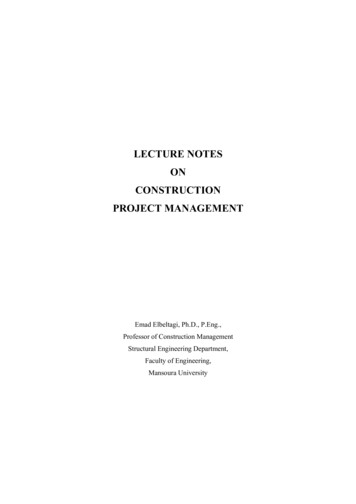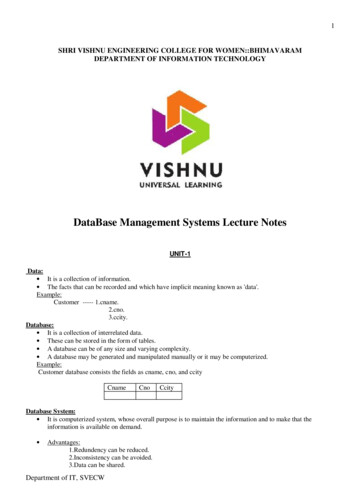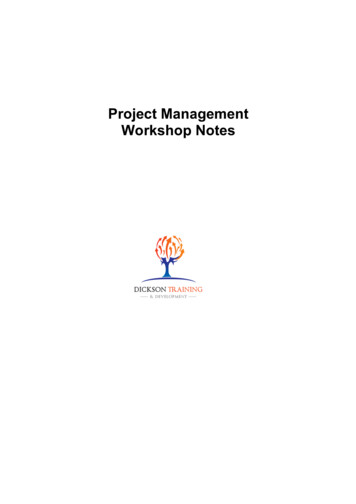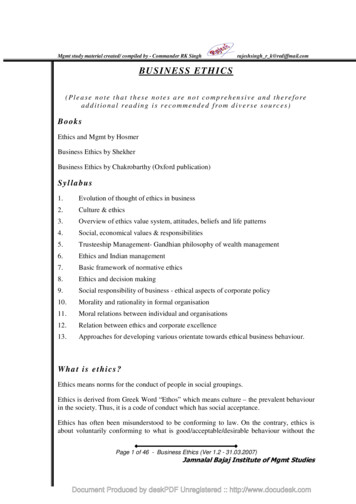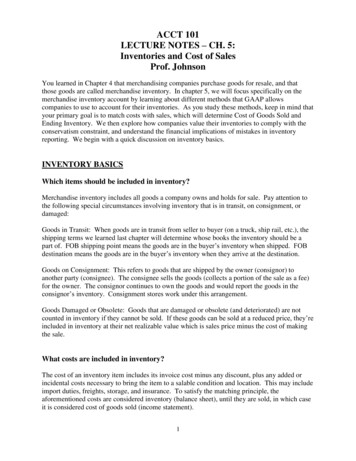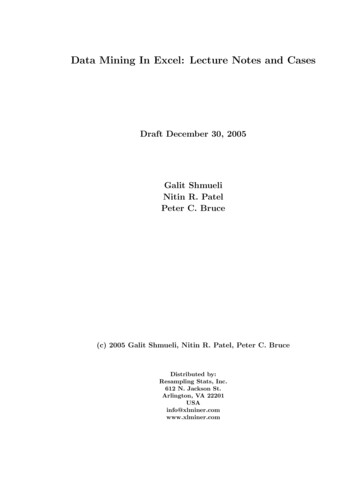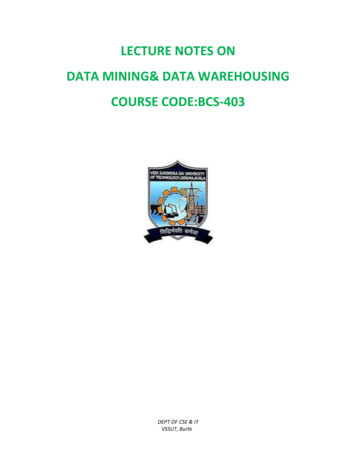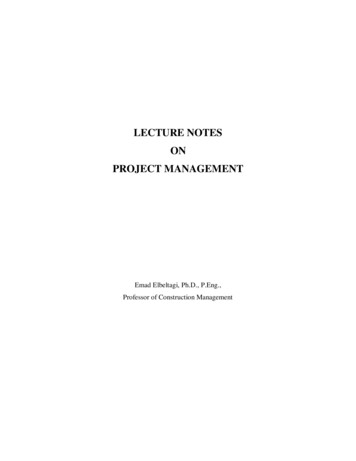
Transcription
LECTURE NOTESONPROJECT MANAGEMENTEmad Elbeltagi, Ph.D., P.Eng.,Professor of Construction Management
Project Management2016Copyright 2016 by the author. All rights reserved. No part of this book may bereproduced or distributed in any form or by any means, or stored in a data base orretrieval system, without the prior written permissions of the author.
PREFACEIn the Name of ALLAH the Most Merciful, the Most CompassionateAll praise is due to ALLAH and blessings and peace be upon His messenger and servant,Muhammad, and upon his family and companions and whoever follows his guidanceuntil the Day of Resurrection.Project management is a relatively young field. However, its impact has been quiteremarkable. It has become an important practice for improving the efficiency of differentoperations around the world. This book deals with some topics and tools of the large fieldof project management.This book is dedicated mainly to undergraduate engineering students. It provides thereader with the main knowledge within the project management filed to manage a givenproject from preliminary stages to handover. It includes seven chapters: Chapter 1provides a general introduction to construction projects in terms of their types, project lifecycle and the main players involved. Chapter 2 is dedicated for the contract strategy.Chapter 3 is dedicated to discuss the organizational structures and human resourcesmanagement concepts. The planning stages of a project and scheduling techniques aepresented in Chapter 4. Chapter 5 is dedicated to discuss the learning theory. Theprinciples of cost estimating is presented in chapter 6. Chapter 7 is dealing with projectrisk management. Many solved examples have been added to enable the students tounderstand the material presented in this book. Also, each chapter is followed byexercises for training purposes.Finally, May ALLAH accepts this humble work and I hope it will be beneficial to itsreaders.i
TABLE OF CONTENTSCHAPTER 1: INTRODUCTION1.1 The Need for Project Management11.2 The Project41.3 The Project Scope and Goals51.4 The Project Life-Cycle91.4.1 Pre-execution phase111.4.2 Procurement phase (Bidding and award phase)121.4.3 Execution Phase131.4.4 Closeout Phase131.5 Major Types of Construction Projects141.5.1 Residential Housing Construction141.5.2 Institutional and Commercial Building Construction151.5.3 Specialized Industrial Construction151.5.4 Infrastructure and Heavy Construction161.6 Construction Projects Participants161.6.1 The Owner (Client)161.6.2 The Design Professionals171.6.3 The Construction Professionals181.6.4 The Project Manager181.7 Projects Stakeholders201.8 Case Study211.8 Exercises22ii
CHAPTER 2: CONTRACT STRATEGY2.1 What is a Contract242.2 Selection of Contract Type252.2.1 Project Objectives262.2.2 Project Constraints272.3 Project Delivery Methods282.3.1 Traditional Approach282.3.2 Direct Labor292.3.3 Design-Build292.3.4 Build-Operate-Transfer (BOT)302.3.5 Professional Construction Management (PCM)302.3.6 Contractual Relationships312.4 Types of Contracts312.4.1 Lump-sum Contract332.4.2 Admeasurement Contract342.4.3 Cost-reimbursable Contract (cost-plus contract)352.4.4 Target Cost Contract352.4.5 Time and Material (T&M) Contract362.5 Contract Administration362.5.1 Contract Documents372.5.2 Conditions of Contract382.5.3 The Standard (general) Forms of Conditions of Contract392.5.4 Special Conditions of Contract412.5.5 Construction claims Contract422.6 Selecting the Contractor432.7 Sub-Contracting432.8 Exercises44iii
CHAPTER 3: HUMAN RESOURCES MANAGEMENT3.1 What is Human Resources Management (HRM)?473.2 Organizational Structures483.2.1 Functional Organization Structure483.2.2 Project Organization Structure503.2.3 Matrix Organization Structure513.3 Human Resources Management Plan543.3.1 Develop HR Plan543.3.2 Acquire Project Team543.3.3 Develop Project Team553.3.4 Manage Project Team573.4 Exercises63CHAPTER 4: PROJECT PLANNING AND SCHEDULING4.1 Introduction674.2 Project Planning Steps684.2.1 Work Breakdown Structure (WBS)694.2.2 Project Activities704.2.3 Activities Relationships724.2.4 Drawing Project Network744.3 The Critical Path Method774.4 Calculations for the Critical Path Method784.5 Schedule Presentation8046 Criticisms to Network Techniques824.7 Solved Examples834.8 Exercises84iv
CHAPTER 5: LEARNING THEORY5.1 Introduction675.2 Productivity685.3 Learning Models Assumption 705.4 Factors Affecting Learning Rates715.5 Variability of Learning Curve725.6 Learning Models735.6.1 Straight-Line Model765.6.2 Stanford "B" Model765.6.3 Cubic Model775.6.4 Piecewise (or Stepwise) Model785.6.5 Exponential Model785.7 Models Data Representation in Learning Curve Theory795.8 Example825.9 Comparison between Data Representing Methods845.10 Using Learning Curves to Predict Future Performance845.11 Forgetting Phenomenon845.12 Exercises86CHAPTER 6: COST ESTIMATING6.1 Purpose of Estimating886.2 Types of Cost Estimating896.3 Conceptual Cost Estimating Basics936.4 Broad Scope of Conceptual Estimates956.5 Conceptual Estimate Adjustment966.5.1 Adjustment for time966.5.2 Adjustment for location986.5.3 Adjustment for Size986.5.4 Combined Adjustment996.5.2 Unit Cost Adjustment996.6 Conceptual Estimating Techniques6.6.1 Interpolation101101v
6.6.2 Unit Method1026.6.3 Superficial Method1036.7 Detailed Estimate of Direct Costs1046.7.1 Unit Rate Estimating1056.7.2 Operational Estimating1056.8 Estimating Indirect Cost1076.8.1 Site Overheads1076.8.2 General Overheads1086.8.3 Contingences1106.8.4 Contractor/Subcontractor profits1116.9 Finalizing a Tender Price1126.9.1 Balanced bid (straight forward method)1126.9.2 Unbalanced bid (loading of rates)1136.10 Exercises115CHAPTER 7: RISK MANAGEMENT7.1 Introduction1187.2 Risk Management Process1207.2.1 Risk Identification1217.2.2 Risk Analysis1237.2.3 Risk Responses1277.2.4 Risk Control1287.3 Program Evaluation and Review Technique (PERT)1297.8 Exercises139REFERENCES144vi
CHAPTER 1INTRODUCTION1.1The Need for Project ManagementWhat is Project Management?Project Management is the application of skills, knowledge, tools and techniques to meetthe needs and expectations of stakeholders for a project. The purpose of projectmanagement is prediction and prevention, NOT recognition and reaction. Projectmanagement is also defined as “the art of organizing, leading, reporting and completinga project through people” or “the efficient utilization of available resources to achieveproject goals”. As such, a project is defined as a planned work and a project manager is aperson who causes things to happen. Therefore, project management is causing a plannedwork to happen.Triple constraintsIncreased Scope increased time increased costTight Time increased costs reduced scopeTight Budget increased time reduced scopeConstruction Management1Dr. Emad Elbeltagi
Key Knowledge Areas of Project ManagementKnowledge areas describe the key competencies that project managers must develop. TheProject Management Institute (PMI) identified ten knowledge areas that a successfulproject manager should have:-Scope Management-Time Management-Cost Management-Quality Management-Communications Management-Risk Management-Procurement Management-Stakeholders management-Resources Management-Integration ManagementThese ten knowledge areas could be classified as follows:-Four core knowledge areas lead to specific project objectives (scope, time,cost, and quality).-Five facilitating knowledge areas are the means through which the projectobjectives are achieved (human resources, communication, risk,procurement management and stakeholders’ management).-One knowledge area (project integration management) affects and isaffected by all of the other knowledge areas.The Construction IndustryThe construction industry is the largest industry in the world. It is more of a service thana manufacturing industry. Growth in this industry in fact is an indicator of the economicconditions of a country. This is because the construction industry consumes a wideemployment circle of labor. While the manufacturing industry exhibit high-qualityproducts, timelines of service delivery, reasonable cost of service, and low failure rates,the construction industry, on the other hand, is generally the opposite. Most projectsexhibit cost overruns, time extensions, and conflicts among parties. Figure 1.1 is anConstruction Management2Dr. Emad Elbeltagi
example of a complicated project. Table 1.1, also, exhibits some magnificent projects thatsuffered from huge cost overruns.Figure 1.1: Example of a complicated projectTable 1.1: Magnificent projects with huge cost overrunsProjectSuez CanalCost overruns (%)1,900Sydney Opera House1,400Concorde Supersonic Aeroplane1,100Panama Canal200Brooklyn Bridge100(Source: Mette K. Skamris, 'Economic Appraisal of Large-Scale TransportInfrastructure Investments', Ph.D dissertation, Aalborg University, 2000).In general, the construction industry is more challenging than other industries due to: itsunique nature; every project is one-of a kind; many conflicting parties are involved;projects are constrained by time, money and quality; and high risk.Construction Management3Dr. Emad Elbeltagi
1.2The ProjectA project is a temporary (definitive beginning and end) endeavor undertaken to produce aunique product or service. A project is defined, whether it is in construction or not, by thefollowing characteristics:-A defined goal or objective.-Specific tasks to be performed.-A defined beginning and end.-Resources being consumed.-Unique purpose-Temporary-Involve uncertainty-As the project progresses, the project team learns more about the projectProject SuccessA project is said to be successful when the following requirements are satisfied:-Completed within allocated time frame.-Customer Requirements satisfied/exceeded.-Completed within allocated budget.-Accepted by the customer.Projects begin with a stated goal established by the owner and accomplished by theproject team. As the team begins to design, estimate, and plan out the project, themembers learn more about the project than was known when the goal was firstestablished. This often leads to a redefinition of the stated project goals.The goal of construction project is to build something. What differentiate the constructionindustry from other industries is that its projects are large, built on-site, and generallyunique. Time, money, labor, equipment, and, materials are all examples of the kinds ofresources that are consumed by the project.Construction Management4Dr. Emad Elbeltagi
Examples of Projects1.3-Developing a new product or service-Effecting a change in structure, staffing, or style of an organization-Writing a book-Designing a new transportation vehicle-Constructing a building or facility-Running a campaign for political office-Implementing a new business procedure or processThe Project Scope and GoalsProject Goal SettingYou can’t hit a target if you don’t know what it looks like. Similarly, you can’t possiblyreach your project’s goal if you don’t know what it is. When you understand how yourproject fits in with the broader company direction, it’s time to really pin down your goal.“But,” you say, “I know exactly what my goal is, because my boss told me.” However, aset of deliverables isn’t necessarily a goal. On first consideration, you might say the goalof expanding the railroad westward in the United States was to enable a train to go fromcoast to coast. But was it? Perhaps the goal of those railroad barons was not to get a trainto go cross country, but to open up opportunities for commerce in the West. It’s time toput the same kind of thought to your project’s goal.Getting your goal straightSay your project involves training new employees in a new software system. Your goal intraining them on this software could be to:-Make employees more productive in their jobs.-Enable employees to better serve customers.-Create a prototype program with reduced training costs that can be used to reduceoverall training costs across the company.Construction Management5Dr. Emad Elbeltagi
-Increase employee retention by providing useful on-the-job skills. These goalssuggest different priorities as well as different measurements for gauging thedegree to which your project has succeeded in meeting its goal.How, exactly, do you go about determining your goal? First, go back to the person whoasked you to take on the project and grill him or her about what’s expected of this project.Should the training have a measurable impact on job performance, customer satisfaction,employee retention, or cost of delivery? The answer you get might be that the projectshould do all of these things. But think about whether that’s realistic and whether one ofthese goals should be paramount in guiding you and your project team. If overall trainingprogram cost reduction is the biggest goal factor, for example, employee productivitymight have to take a back seat when you’re making choices along the way. If customersatisfaction is the real goal, training costs might have to be adjusted accordingly.Writing a goal statementAfter you get more specifics about your project’s goal, it’s a good idea to put your goal inwriting in a goal statement. A goal statement outlines why you’re doing this project andwhat you hope to accomplish at the end. You don’t get down to specific deliverables andparameters in a goal statement. For now, focus on the why and the desired result.Here are a few sample goal statements:-The goal of the project is to upgrade the shopping cart feature on our Web site tobe easier to use so we can increase online sales by 25 percent.-Our goal is to reduce human resource workload by 10 percent by offering selfservice information on job benefits on the company intranet.Using the example of a training project, consider for a moment what such a project mightinvolve. Are you supposed to write new training materials, hire staff to deliver
Project Management is the application of skills, knowledge, tools and techniques to meet the needs and expectations of stakeholders for a project. The purpose of project management is prediction and prevention, NOT recognition and reaction. Project management is also defined as “the art of organizing, leading, reporting and completing a project through people” or “the efficient .

